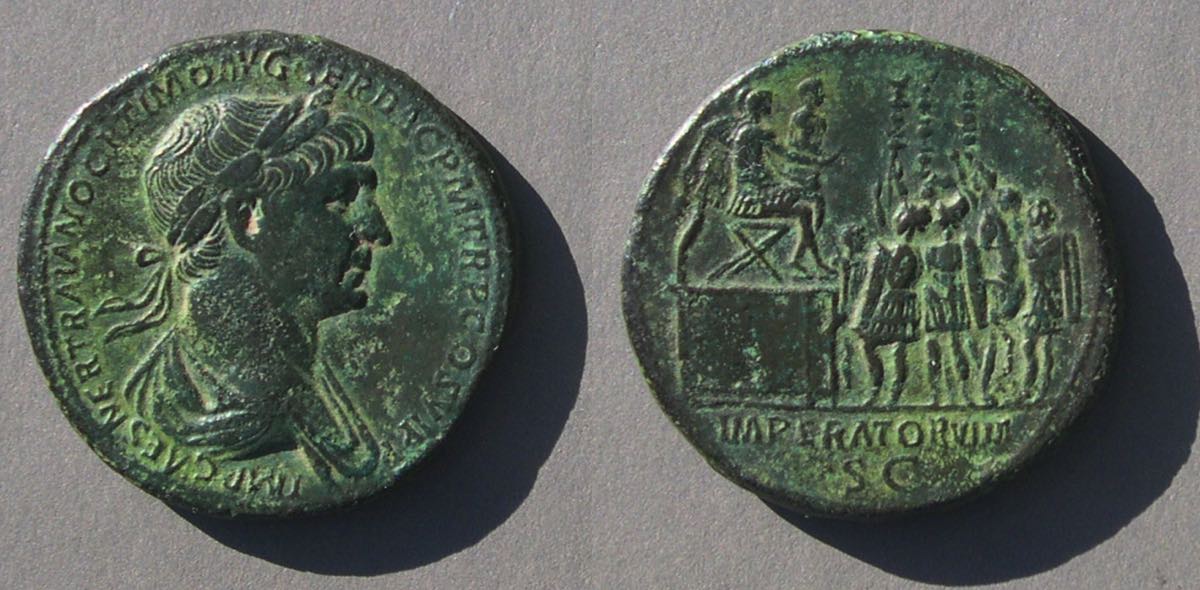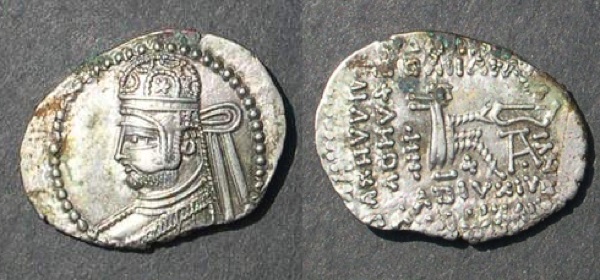Trajan's Parthian Victory.
A coin of Trajan celebrates his Parthian victory by depicting Trajan standing triumphant over Armenia and the two rivers of Mesopotamia.
The emperor Trajan (98-117) added several territories to the Roman empire, including Dacia (in wars of 101-2 and 105-6), Arabia (annexed without a war in 106), and Armenia and Mesopotamia (in his war with Parthia in 113-117). "Mesopotamia" is the "[land] between rivers." The Tigris and Euphrates Rivers which flow from the Armenian highlands of what is now eastern Turkey down to the Arabian Gulf created this fertile area, now in Iraq and parts of Syria. Often the border between Rome and Parthia was the upper Euphrates (The Euphrates is to the west of the Tigris. Lower down the Euphrates bordered the Arabian desert and Rome and Parthia were not in direct contact.)
Rome and Parthia both influenced Armenia by seeking to install friendly kings. Any invasion of one power by the other could not afford to leave an hostile kingdom on their northern flank. In 113 Parthia installed a king unfavorable to Rome which provoked Trajan. He first (re)conquered Armenia and installed his own client king. Then he could march down the Euphrates without enemy troops at his back. The capitol of Parthia, Ctesiphon, was on the Tigris less than 25 miles southeast of modern Bagdad on the Euphrates. Trajan sacked Ctesiphon and marched to the Gulf. He had his Parthian victory.
 Trajan, 98-117.
Trajan, 98-117.
Large sestertius. 34 mm. 29.56 grams.
Bust of Trajan right
Trajan standing right holding spear and parazonium (sheath with short Roman sword)
with Armenia personified (with a distinctive cap) seated at his knee between the river gods of the Euphrates and Tigris reclining (enlarged below).
This coin has the longest legend of any ancient coin with 52 obverse and 44 reverse letters. 96 letters in total.
The obverse reads:
IMP CAES NER TRAIANO OPTIMO AVG GER DAC PARTHICO PM TRP COS VI PP
With abbreviations expanded, it reads: Imperator, Caesar, Nerva (his adoptive father), Trajan, Best [ruler], Augustus, Germanicus (victory over the Germans), Dacicus (victory over the Dacians), Parthico (victory over the Parthians), Pontifex Maximus (high priest), Tribunica Potestas (power of the tribune), Consul six times, Father of his Country.
The reverse reads: ARMENIA ET MESOPOTAMIA IN POTESTATEM P R REDACTAE SC
Armenia and Mesopotamia into the power of the people of Rome taken back [in the form of a province], the Senate consulted
RIC Trajan 642. Sear II 3181. Struck 116 AD.
Look at the figures:

River gods are bearded males reclining, here with reeds found along rivers. They are the outer two figures. Their outer arms lean on amphorae pouring water (especially clear on the left). Provinces are depicted as females, usually holding something distinctive of the province, but here Armenia is seated and her cap is Armenian.
Parthia was large and populated with people hostile to Rome. Trajan realized he could not annex Parthia as a Roman province, rather he intended to install a friendly king who he had brought along on the campaign. Parthamaspates, an exiled son of the dethroned ruler, was elevated as the new Parthian king. Some history books show a map of "The Roman Empire at its Greatest Extent" with Mesopotamia down to the Gulf included, but that is misleading. From this conquest nothing east of the Euphrates river endured after Trajan's march home. Parthamaspates was soon overthrown, but escaped and became a client king of a small territory along the upper Euphrates called Osroene. Trajan's successor Hadrian immediately ceded Mesopotamia back to the Parthians and the Euphrates once again became the border between the Roman and Parthian empires.
Victory Types. Trajan has more victory types than other emperors. Dacian victory types are particularly common, but this Parthian victory type has special appeal with its explicit legend and three personifications.
Related Coins. There are coins depicting numerous related events: the submission of Armenia, Trajan's seventh, eighth, and ninth acclaimations as imperator (the seventh is probably for Armenia, but Trajan had 13 overall and it is uncertain which numbers go with which victories), elevation of the new Parthian king, and the award of the title PARTHICO by the senate. There are also Parthian coins of the new king Parthamaspates.
 Trajan.
Trajan.
Sestertius. 33 mm. 20.07 grams.
IMPERATOR VIII / SC
Trajan seated right on high platform, by him two officers. In front on gound one officer right and four soldiers left and a fifth behind, three standards behind. The fourth soldier holds a horse by its bridle.
RIC 658. Sear II 3187 ("Capture of Singara")
Struck 115 or 116.
This type also comes with numeral VIIII (for the capture of Ctesiphon?).
 Parthian drachm.
Parthian drachm.
24-18 mm. 3.69 grams.
Attributed to Parthamaspates, 116 CE, by Sellwood (81.1) and Shore (423).
The long legend on the first sestertius provoked a CoinTalk thread on coins with long legends:
https://www.cointalk.com/threads/roman-coin-with-the-longest-legend.330700/
Another page has other historical types of Trajan, especially types related to his Dacian Wars.
Return to the Table of Contents page.
 Trajan, 98-117.
Trajan, 98-117.
 Trajan.
Trajan. Parthian drachm.
Parthian drachm.